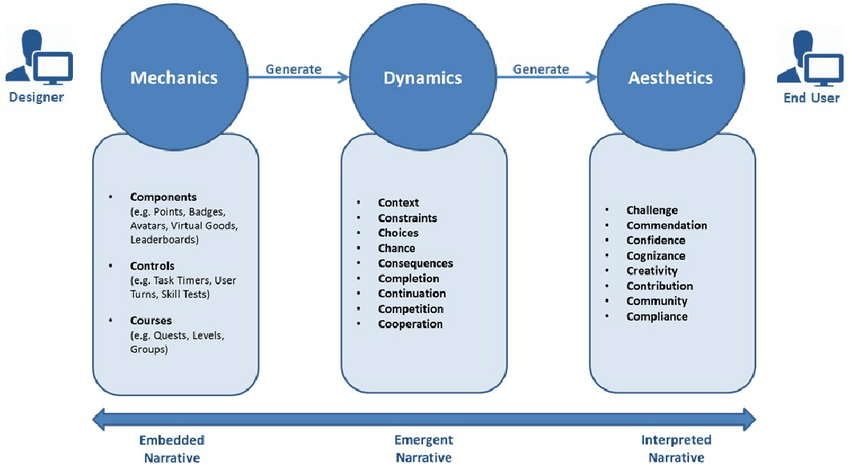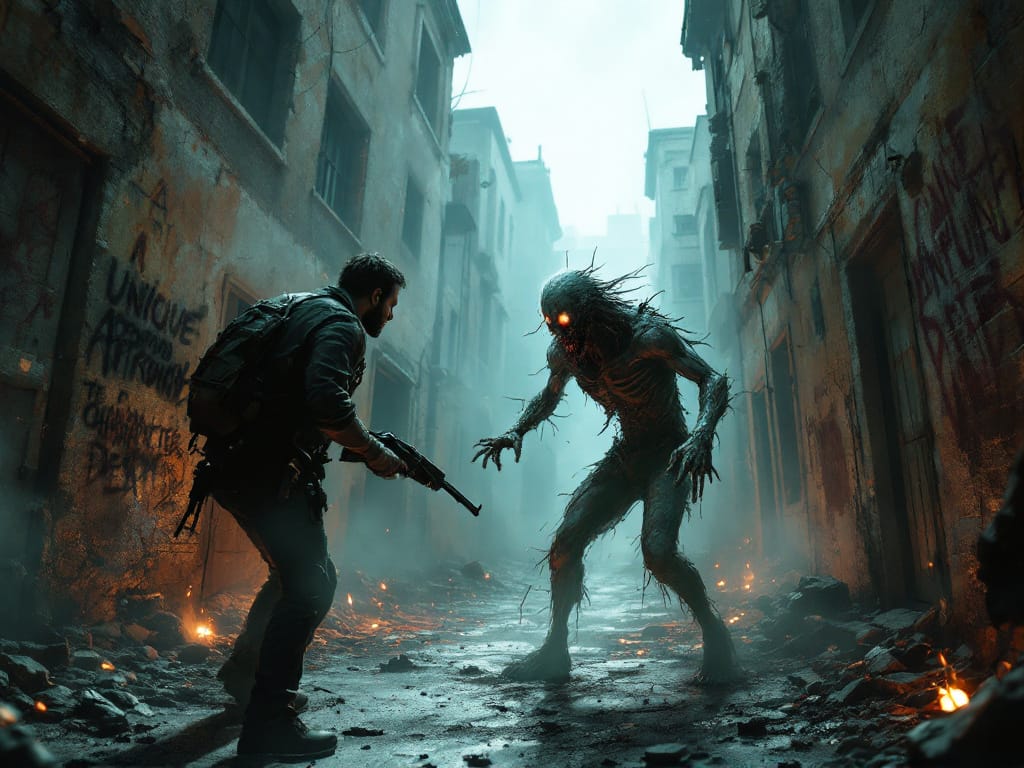In the development of the horror game Alien: Isolation, the team made significant changes to the save system to enhance the desired player experience.
This blog post delves into how analyzing game mechanics using the MDA framework influenced their decision-making process. By exploring the interplay between mechanics, dynamics, and aesthetics, designers can craft a more immersive and emotionally impactful game.
Key Article Summary:
- The MDA framework breaks down game design into mechanics, dynamics and aesthetics. Analyzing these components provides insights into creating engaging gameplay.
- Mechanics are the rules and systems governing gameplay. Dynamics emerge from player interactions with the mechanics. Aesthetics relate to the emotional experience.
- In Alien: Isolation, the automatic save system reduced fear and challenged the horror aesthetics. The shift to limited manual saves increased vulnerability, consequences and isolation.
- This change illustrates the importance of aligning mechanics with desired emotions and experiences. Player subjectivity means aesthetics are not universal.
- Frameworks like MDA allow designers to systematically analyze games and make informed design decisions to craft engaging experiences.

Analyzing Game Mechanics with the MDA Framework
The Mechanics of Games
When it comes to understanding games, breaking them down into their fundamental components is crucial. The MDA framework offers a helpful approach by dividing games into three key elements: mechanics, dynamics, and aesthetics.
The discussion will commence by directing attention towards mechanics. When it comes to games, the term “mechanics” encompasses the rules, systems, and statistics that govern how the game operates. These constitute the fundamental elements that dictate what actions players can or cannot undertake within the virtual realm.
In the role-playing game (RPG) called “The Witcher 3: Wild Hunt,” picture yourself immersed in an interactive virtual world. This game introduces various mechanics, including combat system, character progression, inventory management, as well as a comprehensive range of skills and abilities that you can utilize. These mechanics govern your engagement and interactions within the game’s captivating universe.
Mechanics can vary significantly depending on the genre and type of game. To illustrate, in a puzzle game like “Tetris,” players manipulate falling blocks to create complete lines as the central mechanics. In contrast, strategy games like “Civilization VI” revolve around managing resources, conducting diplomacy, and engaging in warfare as key gameplay mechanics.
Understanding the game mechanics the mechanics of a game is crucial for both players and game designers.
Players need to understand the rules and systems in order to navigate the game effectively and make informed decisions. On the other hand, designers use mechanics to shape the player experience and create engaging and rewarding gameplay.
From a deeper perspective, game mechanics can also be analyzed. Game theorists delve into the mathematical properties and formal structures of mechanics to gain insights into the complexity and strategic depth of games. This level of analysis aids designers in creating balanced mechanics that provide challenges and foster strategic thinking.

The Dynamics of Games
When it comes to understanding a game, mechanics define the rules and systems, while dynamics delve into how players behave and interact within those mechanics. Dynamics encompass the fascinating emergence of behaviors and actions driven by the interplay between mechanics and player agency.
“The Witcher 3: Wild Hunt,” a previously mentioned RPG, offers players intricate dynamics. These dynamics encompass navigating complex moral choices, building relationships with non-player characters (NPCs), and approaching quests and missions. The extent of these dynamics depends on individual player preferences and playstyles.
Dynamics within a game world are what create distinct and personalized experiences for each player. These dynamics depend on the choices made by players and the resulting consequences. By offering freedom and agency, dynamics immerse players in the game and foster a deep sense of investment.
Game dynamics are enhanced through emergent gameplay. Such gameplay is characterized by the unforeseen and unplanned experiences that arise from player interactions with the mechanics. These unexpected moments create memorable and spontaneous situations, adding freshness and excitement to each playthrough.
In the sandbox game “Minecraft,” players have the freedom to shape their own world and construct structures using virtual blocks. The game’s dynamics are fueled by the creativity and imagination of its players. Some choose to prioritize survival, engaging in resource gathering and exploration, while others focus on designing intricate structures or even recreating renowned landmarks.
Both players and game designers recognize the significance of understanding the mechanics behind a game. Players must consider how their choices and actions will shape the gaming world and influence their overall experiences. Conversely, designers meticulously construct engaging mechanisms that ensure players enjoy immersive gameplay.

The Aesthetics of Games
Mechanics and dynamics encompass the concrete aspects of games, while aesthetics explore the emotional responses and sensations that players encounter during gameplay.
A game’s aesthetics encompass its sensory experiences, narrative elements, and overall atmosphere. They have the power to shape players’ emotional engagement and significantly contribute to their enjoyment and impact of the gameplay experience.
“The Witcher 3: Wild Hunt” effectively uses aesthetics to immerse players in a vivid and atmospheric world. From its stunning landscapes to the haunting music, from well-crafted dialogue to intricate characters, every element contributes to the game’s aesthetics, evoking a range of emotions including excitement, sadness, and awe.
Aesthetics can be further divided into different dimensions:
- The sensory aesthetics dimension of a game emphasizes the sensory elements that enhance the overall experience. This includes visual, auditory, and haptic components. High-quality graphics, realistic sound effects, and responsive controls all contribute to creating an immersive sensory experience for players.
- Narrative aesthetics refer to the storytelling and narrative aspects of a game. A captivating storyline featuring well-developed characters and exciting plot twists can significantly enhance the overall aesthetic experience.
- Emotional aesthetics encompass the range of emotions elicited by games. Whether it be fear, joy, sadness, or excitement, gameplay, visual design, and storytelling intertwine to evoke these emotional responses.
- Symbolic aesthetics delve into the profound meaning that resides within a game. The intertwined symbolism and metaphors can manifest themselves through various mediums, including game mechanics, visuals, and narratives. These elements provide an opportunity for deeper interpretations and emotional connections, enhancing the overall experience.
By considering all these aspects, game designers have the ability to craft immersive and captivating experiences that deeply resonate with players across various dimensions.
The MDA framework offers a comprehensive method for comprehending and assessing game mechanics, including the mechanics, dynamics, and aesthetics. Through this analysis, both players and designers can gain valuable insights into what makes a game captivating, enjoyable, and memorable. It serves as the backbone of game design by ensuring that all elements of a game are seamlessly integrated to create a cohesive and immersive experience for players.

Aligning Mechanics with Desired Emotions
When designing a game, one must consider how the mechanics align with the desired emotions and experiences for players. A clear vision and understanding of the intended player emotions is crucial for designers. Through careful craftsmanship of the mechanics, designers can enhance these emotions, creating an immersive gaming experience.
The mechanics of a game encompass the rules and systems that govern gameplay. These mechanics include controls, objectives, and player interactions within the game world. By shaping how players interact with the game, mechanics have the power to create enjoyable, challenging, and engaging experiences. It is therefore essential for designers to thoughtfully align these mechanics with desired emotions and experiences they intend for players to have.
The Importance of a Clear Vision
Designers must first establish a clear vision for the game before delving into its mechanics. This entails comprehending the desired emotions, player experiences, and overall message or theme. A well-defined vision acts as a guiding force throughout the design process, ensuring seamless integration of all game elements.
Inducing Desired Emotions and Feelings
Once the vision is established, designers can then prioritize aligning the mechanics with the desired emotions and feelings. For instance, if the goal entails creating a fast-paced and adrenaline-fueled experience, it becomes essential to design dynamic mechanics with quick and responsive controls. On the contrary, if the aim is to evoke a sense of relaxation and tranquility, it becomes necessary for the mechanics to adopt a more meditative and calming approach.
Designers can utilize game mechanics to evoke specific emotions. If the game’s theme is centered around survival, mechanics like limited resources or challenging obstacles can create a sense of tension, fear, and excitement. Conversely, when the objective is to foster collaboration, incorporating mechanics such as cooperative gameplay or shared resources can instill feelings of camaraderie and teamwork.
Considering Other Elements
While the mechanics of a game play a vital role in shaping a player’s experience, they are not the sole contributors to its overall aesthetics. The visual style, music, animation, and story all work together harmoniously to create an immersive and cohesive experience for players. It is crucial for these elements to align with the desired emotions and experiences that the game aims to deliver.
Explanation:
The improved version of the sentence incorporates shorter and more concise sentences while maintaining clarity. The use of transitional phrases helps establish smooth flow between ideas. By avoiding contractions, slang, or colloquialisms and adhering to proper grammar rules, the writing maintains a neutral tone and objective style. The content focuses on presenting information in a clear and organized manner while skillfully
The visual style of a game has the power to establish its tone and atmosphere. For instance, a dark and gloomy visual style can evoke feelings of mystery or fear, while a bright and colorful style may generate a sense of joy and excitement. Furthermore, the incorporation of music and sound design can further intensify these emotions. A thrilling soundtrack can enhance action sequences, whereas a soothing melody can create a relaxing ambiance.
Animation and story both play a significant role in enhancing the overall experience. Thoughtfully crafted animations breathe life into the game, adding dynamism and vitality. Meanwhile, a captivating story provides players with purpose and investment, evoking emotions aligned with their desired experience. These elements synergistically complement the mechanics, resulting in a seamless and immersive world.
The Importance of Alignment
When all aspects of the game, including mechanics, visuals, music, animation, and story are harmoniously aligned, it becomes crucial to create a cohesive and immersive experience for players. This alignment ensures that desired emotions and experiences are supported seamlessly, ultimately leading to full engagement from players.
Moreover, the alignment between mechanics and desired emotions holds significant influence over a player’s satisfaction and enjoyment. If the mechanics fail to elicit the intended emotions, players might experience a sense of detachment or lack of interest in the game. Conversely, when mechanics and emotions harmonize seamlessly, players are more inclined to undergo an extraordinary and fulfilling gaming experience.
The Importance of Player Response
In the field of game design, aesthetics play a vital role in delivering an immersive and captivating experience for players. However, it is crucial for designers to acknowledge that aesthetic preferences are subjective. Different players may have distinct emotional reactions to the mechanics incorporated within a game. This understanding becomes pivotal for crafting a game that deeply resonates with players on an emotional level.

The Save System in Alien: Isolation
One prime example that illustrates how player response can shape game design is the save system implemented in the horror game Alien: Isolation. At first, the game utilized an automatic save system where progress was saved at significant checkpoints without requiring any input from the player. While this approach may appear convenient and user-friendly, it inadvertently had unforeseen consequences on the overall gaming experience.
In Alien: Isolation, the inclusion of an automatic save system made players feel secure and fearless. They knew that their progress would be saved without any manual effort. However, this convenience was not ideal for a horror game aimed at creating a sense of tension, fear, and isolation. It undermined the intended challenge and immersion as players had the assurance that they could easily revert to a previous save if things went awry.
The developers tackled the issue by implementing a significant change to the save system. They opted for a manual save approach, replacing the previous automatic system. However, this new method only provided limited save points. As a result of this modification, players experienced remarkable shifts in their emotional reactions and overall gameplay encounters.
The Shift to a Manual Save System
The game developers intentionally introduced a manual save system in Alien: Isolation to amplify its horror and isolation themes. This deliberate change requires players to carefully strategize when and where they save their progress, infusing the gameplay with tension and unease.
To enhance the readability and coherence of the sentence, it can be divided into shorter sentences while still maintaining the original ideas.
By limiting the number of available save points, players faced the risk of losing significant progress. Mistakes or challenging situations could have severe consequences in this game. The palpable sense of risk mirrored the atmosphere of the game, immersing players further. They had to carefully consider advancing versus risking their progress, heightening both stakes and immersion.
Explanation:
In order to improve readability according to Hemingway guidelines, I have made several changes:
- Divided long and complex sentences into shorter ones with clear subjects and predicates.
- Simplified language without sacrificing clarity.
- Maintained a neutral tone to suit a general audience.
- Ensured smooth transitions between ideas for logical flow.
- Incorporated descriptive phrases without explicitly referencing
The manual save system added vulnerability and isolation to players. With limited save points, they had to navigate hostile environments without the safety net of frequent saves. This intensified their sense of being alone and unprotected in a dangerous world. These emotions are crucial in the horror genre, and the manual save system effectively heightened them.

The Subjective Nature of Player Response
Alien: Isolation’s save system provides a compelling illustration of how player response can influence game design. It emphasizes the significance of acknowledging the subjective nature of aesthetics since different players may have distinct emotional reactions to game mechanics.
Designers must understand that what works for one player may not work for another. By considering this variability, designers can tailor their games to elicit specific emotional responses, ensuring a more engaging and immersive experience for a broader range of players. Additionally, the example of Alien: Isolation highlights the importance of aligning game mechanics with the intended emotional tone and themes. Initially, the automatic save system undermined the elements of horror and isolation in the game. However, by implementing a manual save system, these aspects were effectively reinforced.
Making Informed Decisions
When it comes to game design, selecting or creating the appropriate game mechanics is of utmost importance. Game mechanics encompass the regulations and systems that govern gameplay and interactions within a game. They dictate how players engage with the virtual world and determine which actions and behaviors receive rewards or penalties. The choice of game mechanics can significantly influence players’ emotions and overall gaming experiences. Thus, designers must meticulously consider the mechanics they employ.
Designers can utilize the MDA (Mechanics, Dynamics, Aesthetics) framework as a valuable approach for making informed decisions about game mechanics. This framework offers a structured method to analyze and comprehend the interplay between mechanics, dynamics, and aesthetics in games. By taking into account these three key elements, designers have the ability to create captivating and immersive experiences that truly engage players.

The MDA Framework
The MDA framework was devised in 2004 by Robin Hunicke, Marc LeBlanc, and Robert Zubek. These three visionaries broke down games into three distinct components.
- The mechanics of a game encompass its rules and systems, governing the inner workings and functionality. They dictate the actions available to players, how they can perform them, and the subsequent outcomes. Mechanics may include elements like movement, combat, resource management, puzzles, and more. When crafting game mechanics, it is crucial to assess their alignment with desired emotions and experiences
- Dynamics are the emergent interactions and behaviors that arise from combining game mechanics with player input. They result from players engaging with the mechanics and making choices throughout the game, encompassing elements such as competition, cooperation, exploration, progression, and more. It is vital to consider how these dynamics created by the mechanics contribute to shaping the desired player experience.
- Aesthetics: The emotional responses and experiences players have while playing a game encompass its aesthetics. These aesthetics involve various feelings, including challenge, curiosity, excitement, achievement, immersion, relaxation, and more. Designers can shape the mechanics and dynamics of a game to evoke specific emotions and create the desired player experience by understanding these desired aesthetics.
The MDA framework offers game designers a structured approach to designing games. By considering the mechanics, dynamics, and aesthetics, they can align their decisions with the desired player experience. This framework empowers designers to make informed choices in creating engaging and enjoyable games.
Analyzing Game Mechanics
When designing game mechanics, it becomes crucial to analyze and evaluate their effectiveness. This analysis assists designers in ensuring that the mechanics align with the intended emotions and experiences. Several factors need consideration when analyzing game mechanics.
Cognitive Load:The cognitive load refers to the mental effort that players need to exert in order to understand and engage with the mechanics of a game. If the mechanics are overly complex or difficult to grasp, it can lead to frustration and hinder players from fully enjoying the game. Game designers should aim for mechanics that strike a balance between challenge and accessibility.
Player agency refers to the level of control and freedom that players have within a game. When mechanics provide meaningful choices and empower players to influence the game world, it enhances player engagement and investment. Designers must consider how these mechanics enable decision-making by players.
Balancing: The process of balancing in game design is crucial to ensure a fair and enjoyable experience for all players. It involves examining the various mechanics and elements within the game to minimize any biases towards specific playstyles or potential imbalances that may lead to frustration and dissatisfaction. Game designers should prioritize creating mechanics that provide a balanced and rewarding experience for every player involved.
Feedback and rewards are essential for motivating players and reinforcing desired behaviors. When game mechanics provide clear and meaningful feedback, along with appropriate rewards, they have the power to enhance player engagement and satisfaction. Designers should carefully consider how these mechanics effectively communicate progress and success to players.
Game mechanics have the ability to elicit specific emotions within players. Designers must consider how these mechanics contribute to the intended emotional experience. For instance, mechanics that generate tension and suspense can heighten the immersion and excitement of a game, while mechanics that foster social interaction can evoke feelings of camaraderie and cooperation among players.
By analyzing and evaluating game mechanics based on these factors, designers can make well-informed decisions. These decisions ultimately result in creating more engaging and immersive experiences for players.
Creating Engaging Experiences
Game mechanics play a crucial role in creating captivating and immersive experiences for players. Designers can enhance engagement by carefully selecting or developing mechanics that align with the desired emotions and experiences. These thoughtful choices enable the crafting of games that captivate and entertain players. To create engaging game mechanics, consider the following tips:
- Research and Inspiration: Stay informed about current trends and best practices in game design. Take inspiration from successful games and analyze their mechanics to understand what makes them engaging.
- User Testing: Regularly test and iterate on your game mechanics. Take feedback from players and use it to refine and improve your design. User testing allows you to identify any issues or areas for improvement in your mechanics.
- Iterative Design: Game design is an iterative process. Don’t be afraid to experiment with different mechanics and iterate on your design. Learn from player feedback and make changes accordingly.
- Consider Context: Consider the context in which players will be experiencing your game. Tailor your mechanics to suit the platform, audience, and overall game experience.
- Collaborate: Collaborate with other designers and gather different perspectives. Working with a team can lead to more innovative and engaging mechanics.
- Take Risks: Don’t be afraid to take risks and try something new. Innovative and unique mechanics can make your game stand out and create a memorable experience for players.
- Observe Player Behavior: Observe how players interact with your game mechanics. Pay attention to their reactions and adjust your mechanics accordingly. This will help you create mechanics that resonate with players.
By following these tips and considering the MDA framework, designers can enhance player engagement and create memorable experiences through game mechanics. Making informed decisions about game mechanics is crucial for captivating and delighting players.
Conclusion: Analyzing Game Mechanics
The use of the MDA framework in the design process of Alien: Isolation demonstrates the importance of aligning game mechanics with the desired player experience. By analyzing the relationship between mechanics, dynamics and aesthetics, the developers were able to identify issues with the automatic save system.
The shift to a manual save system enhanced the horror and isolation themes by eliciting greater feelings of vulnerability and consequence in players. This example highlights the need for designers to consider the subjective nature of player experiences and intentionally craft mechanics that align with the game’s desired emotional impact. Thoughtful application of frameworks like MDA allows designers to make informed decisions that shape engaging and memorable gameplay experiences.
if you want to read more articles about game and level design then don´t following to read out blog.






















